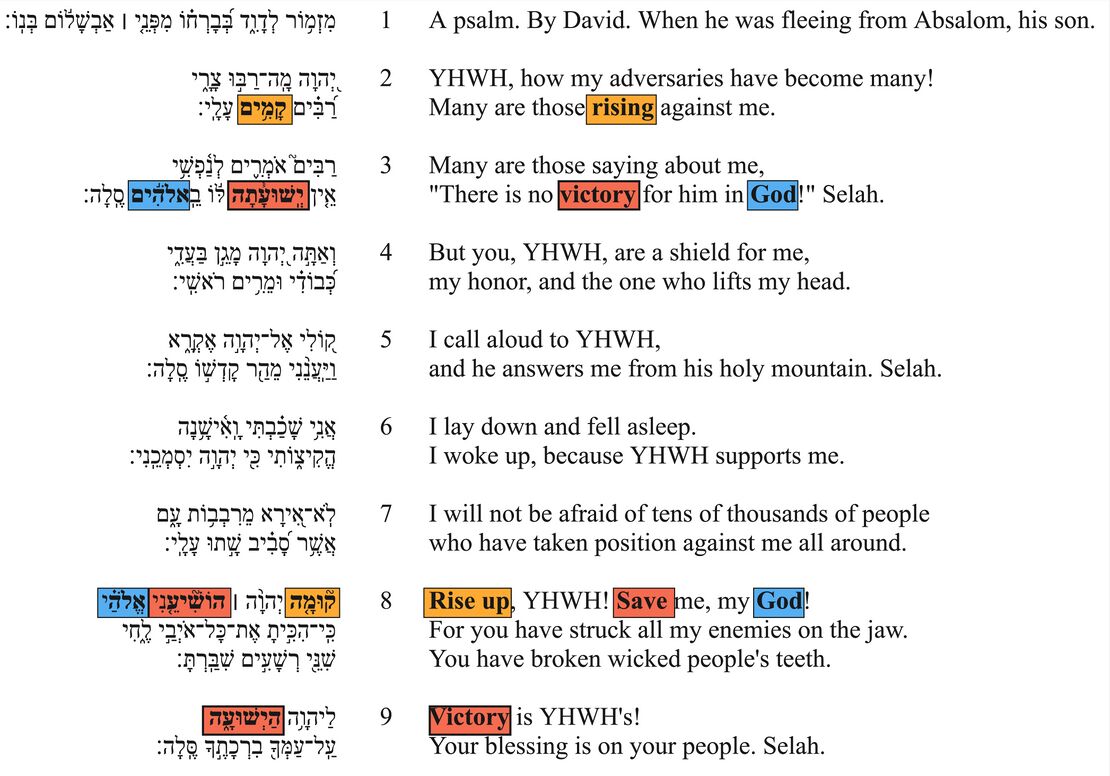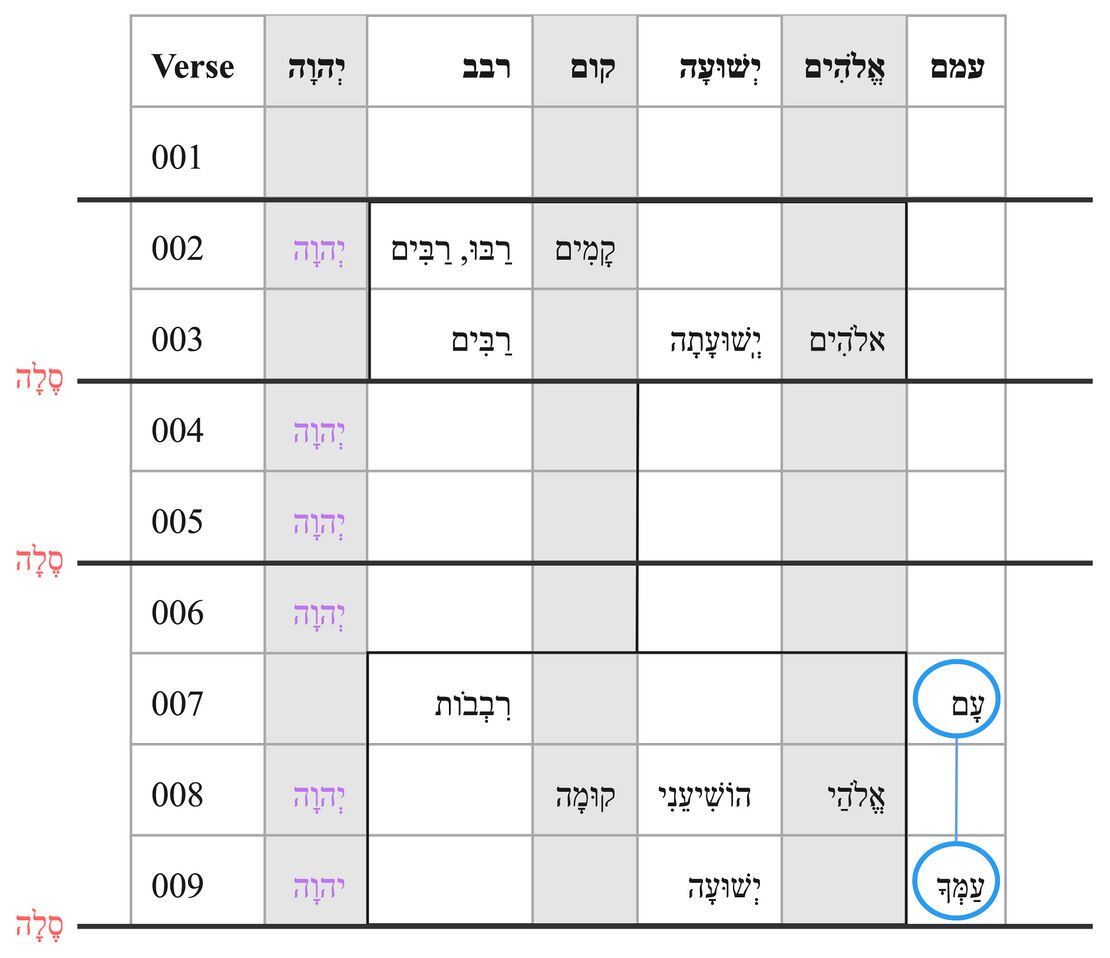Psalm 3 Poetic Features
Poetic Features
In poetic features, we identify and describe the “Top 3 Poetic Features” for each Psalm. Poetic features might include intricate patterns (e.g., chiasms), long range correspondences across the psalm, evocative uses of imagery, sound-plays, allusions to other parts of the Bible, and various other features or combinations of features. For each poetic feature, we describe both the formal aspects of the feature and the poetic effect of the feature. We assume that there is no one-to-one correspondence between a feature’s formal aspects and its effect, and that similar forms might have very different effects depending on their contexts. The effect of a poetic feature is best determined (subjectively) by a thoughtful examination of the feature against the background of the psalm’s overall message and purpose.
Rise and Save
If an emendation or revocalization is preferred, that emendation or revocalization will be marked in the Hebrew text of all the visuals.
| Emendations/Revocalizations legend | |
|---|---|
| *Emended text* | Emended text, text in which the consonants differ from the consonants of the Masoretic text, is indicated by blue asterisks on either side of the emendation. |
| *Revocalized text* | Revocalized text, text in which only the vowels differ from the vowels of the Masoretic text, is indicated by purple asterisks on either side of the revocalization. |
Feature
There are three words that appear only in the first section (vv. 2-3) and the final section (vv. 8-9) of the psalm: “rise”, “victory”/“save”, “God.”
The root for "victory/save" (ישע) is especially marked in this Psalm. Not only does it occur three times, but it occurs in unique forms. In v. 3 it has a unique suffix (יְֽשׁוּעָ֓תָה) and prosodic prominence (rare accent [shalshelet qatan] and occurrence of nesigah [shifting forward of the stress]). In v. 9 it occurs with the full definite article (הַיְשׁוּעָ֑ה, the only word in the Psalm with the full article).
Effect
The repetition of key words in this last section resolves the crisis and sets the record straight. The enemies may have been "rising" in v. 2, but they are no match for YHWH when, in v. 8, he is called to "rise." The enemies might say in v. 3 that “there is no victory/salvation for him in God,” but it is in vain: for David calls upon his “God” (v. 8) to “save” him, revealing the truth that, yes, there is indeed victory/salvation for him, because “victory/salvation belongs to YHWH” (v. 9a), and YHWH is his God.
Thus, the repetition sets up a contrast between the enemies' view of the situation and the reality of the situation. The enemies may act and speak as they like, but they are powerless when faced with YHWH. He will do as he pleases, and he will have the last word.
The Sounds of Silencing
If an emendation or revocalization is preferred, that emendation or revocalization will be marked in the Hebrew text of all the visuals.
| Emendations/Revocalizations legend | |
|---|---|
| *Emended text* | Emended text, text in which the consonants differ from the consonants of the Masoretic text, is indicated by blue asterisks on either side of the emendation. |
| *Revocalized text* | Revocalized text, text in which only the vowels differ from the vowels of the Masoretic text, is indicated by purple asterisks on either side of the revocalization. |
Feature
Verse 8 stands out in a number of ways:
- Poetic structure (the only three-line verse in the Psalm).
- Graphic imagery (striking jaws and breaking teeth).
- Dense alliteration (hard k in 8b [x3]; sh in 8c [x3]; both of which echo sounds in "rise" and "save" in 8a).
- Clustering of imperatives (8a), the only imperatives in the psalm.
- Chiastic patterning of v. 8bc based on syntax and semantics (a strike, b enemies, c jaw // c' teeth, b' wicked, a' shatter).
Effect
The effect of this clustering of poetic features is to draw attention to this climactic point in the psalm, where David calls on YHWH to take action against his enemies.
The repetition of the hard k sound in 8b mimics the sound of striking (also the repetition of the t sound in this line, as well as the ח sound), while the repetition of sh in 8c mimics the silence experienced by the now toothless enemies.[1]
Just as YHWH has struck and silenced every one of David's enemies in the past, so David calls on him to do it again. Those who mock him and his God (cf. v. 3) will be shamed and silenced.
Response to Taunts
If an emendation or revocalization is preferred, that emendation or revocalization will be marked in the Hebrew text of all the visuals.
| Emendations/Revocalizations legend | |
|---|---|
| *Emended text* | Emended text, text in which the consonants differ from the consonants of the Masoretic text, is indicated by blue asterisks on either side of the emendation. |
| *Revocalized text* | Revocalized text, text in which only the vowels differ from the vowels of the Masoretic text, is indicated by purple asterisks on either side of the revocalization. |
Feature
The first words of the second section (vv. 4-5) echo the last words of the first section (vv. 2-3). The words אֹמְרִים לְנַפְשִׁי in v. 3a are similar to וּמֵרִים רֹאשִׁי in v. 4b both in terms of sound (me + rim + shi) and morphology (participles). Similarly, the ending of יְֽשׁוּעָ֓תָה in v. 3b sounds like אַתָּ֣ה in v. 4a, and the words אֱלֹהִים (v. 3b) and יְהוָה (v. 4a) are semantically similar. There is also a subtle end-rhyme between אֵין and מָגֵן.
Effect
In terms of structure, this feature creates a chiasm (abba), which functions as a seam across the first two sections of the Psalm, binding them together into a larger whole. (See Poetic Structure.)
Rhetorically, the repetition of sounds (in reverse order) represents an undoing of the enemies' words. "The enemies' taunt that there is no salvation for the psalmist in God (v. 3) is answered in chiastic form by the psalmist's confident assertion of Yahweh's power to protect him ( v. 4)."[2]
Repeated Roots
The repeated roots table is intended to identify the roots which are repeated in the psalm.
| Repeated Roots legend | |
|---|---|
| Divine name | The divine name is indicated by bold purple text. |
| Roots bounding a section | Roots bounding a section, appearing in the first and last verse of a section, are indicated by bold red text. |
| Roots occurring primarily in the first section are indicated in a yellow box. | |
| Roots occurring primarily in the third section are indicated in a blue box. | |
| Roots connected across sections are indicated by a vertical gray line connecting the roots. | |
| Section boundaries are indicated by a horizontal black line across the chart. | |
Notes
- The divine name יְהוָה occurs six times.
- The repeated word סֶלָה occurs three times and defines three groups: vv. 2-3 [excluding v. 1 as superscription]; vv. 4-5; vv. 6-9. Most of the repeated roots, occur in the first and last group. There are no repeated roots in vv. 4-6, except for the divine name.
- A cluster of repeated roots occurs in vv. 2-3 and vv. 7-9:
- רבב (vv. 2-3, 7) x4
- ישׁע (vv. 3, 8-9) x3
- קום (vv. 2, 8) x2
- אלהים (vv. 3, 8) x2
- The word עָם repeats only in the last three verses of the psalm.
- The word יְשׁוּעָה is especially marked. Not only does the root ישׁע occur three times (vv. 3, 8-9), but the first occurrence has a rare morphology (יְשׁוּעָתָה) and the last occurrence has the definite article (הַיְשׁוּעָה).









